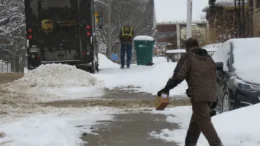CANNON BALL, N.D. (AP) — Armed soldiers and law enforcement officers dressed in riot gear and driving trucks, military Humvees and buses moved in Thursday to force Dakota Access pipeline protesters off private land where they had camped to block construction.
Sirens blared and officials told protesters over a loudspeaker to move out as they advanced slowly on the camp from the north and west. Two helicopters and an airplane monitored the operation from the air.
After an initial confrontation on a highway outside the camp in North Dakota, the majority of the protesters retreated back to the camp, where they were awaiting the arrival of the authorities.
An Associated Press reporter at the scene said that about 200 protesters remain there, listening to elders, burning sage and praying.
The operation to push out the protesters began a day after they had refused to leave voluntarily.
Morton County Sheriff Kyle Kirchmeier said in a statement that the protesters’ actions “forced law enforcement to respond.”
“I can’t stress it enough, this is a public safety issue,” he said. “We cannot have protesters blocking county roads, blocking state highways or trespassing on private property.”
Robert Eder, a 64-year-old Vietnam War veteran from the Standing Rock Reservation, said protesters weren’t scared.
“If they take everybody to jail, there will be twice as many tomorrow, and every day that passes more will come,” he said. “If they raze these teepees, tomorrow we will be back.”
The months-long dispute over the four-state, $3.8 billion pipeline reached a crisis point when the protesters set up camp on land owned by pipeline developer Energy Transfer Partners. The disputed area is just to the north of a more permanent and larger encampment on federally-owned land where hundreds of protesters have camped for months.
Law enforcement officials demanded that the protesters leave the private land on Wednesday, but they refused. Thick fog and cloudy skies on Wednesday appeared to stall the law enforcement effort, but the sun came out on Thursday with scattered clouds and a light breeze. Officials have frequently monitored protesters by air.
The Federal Aviation Administration is restricting flights over the Cannon Ball area until Nov. 5, allowing only aircraft affiliated with the North Dakota Tactical Operation Center and banning drones.
The activists fear the pipeline could harm cultural sites and drinking water for the Standing Rock Sioux tribe. The company and the state of North Dakota say no sensitive cultural sites have been found.
Protests supporting the Standing Rock Sioux have been ongoing for months, with more than 260 people arrested before Thursday’s operation.
The pipeline is to carry oil from western North Dakota through South Dakota and Iowa to an existing pipeline in Patoka, Illinois, where shippers can send it on to Midwest and Gulf Coast markets. Energy Transfer Partners has said the pipeline is nearly complete other than the work in south central North Dakota.
The protest has drawn the attention of activists and celebrities, including actress-activist Shailene Woodley and Green Party presidential candidate Jill Stein. Civil rights activist Jesse Jackson and actor Mark Ruffalo were at the protest camp Wednesday but departed later in the day.
































